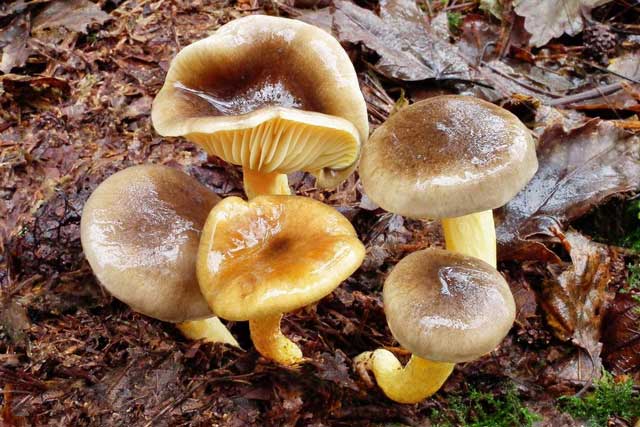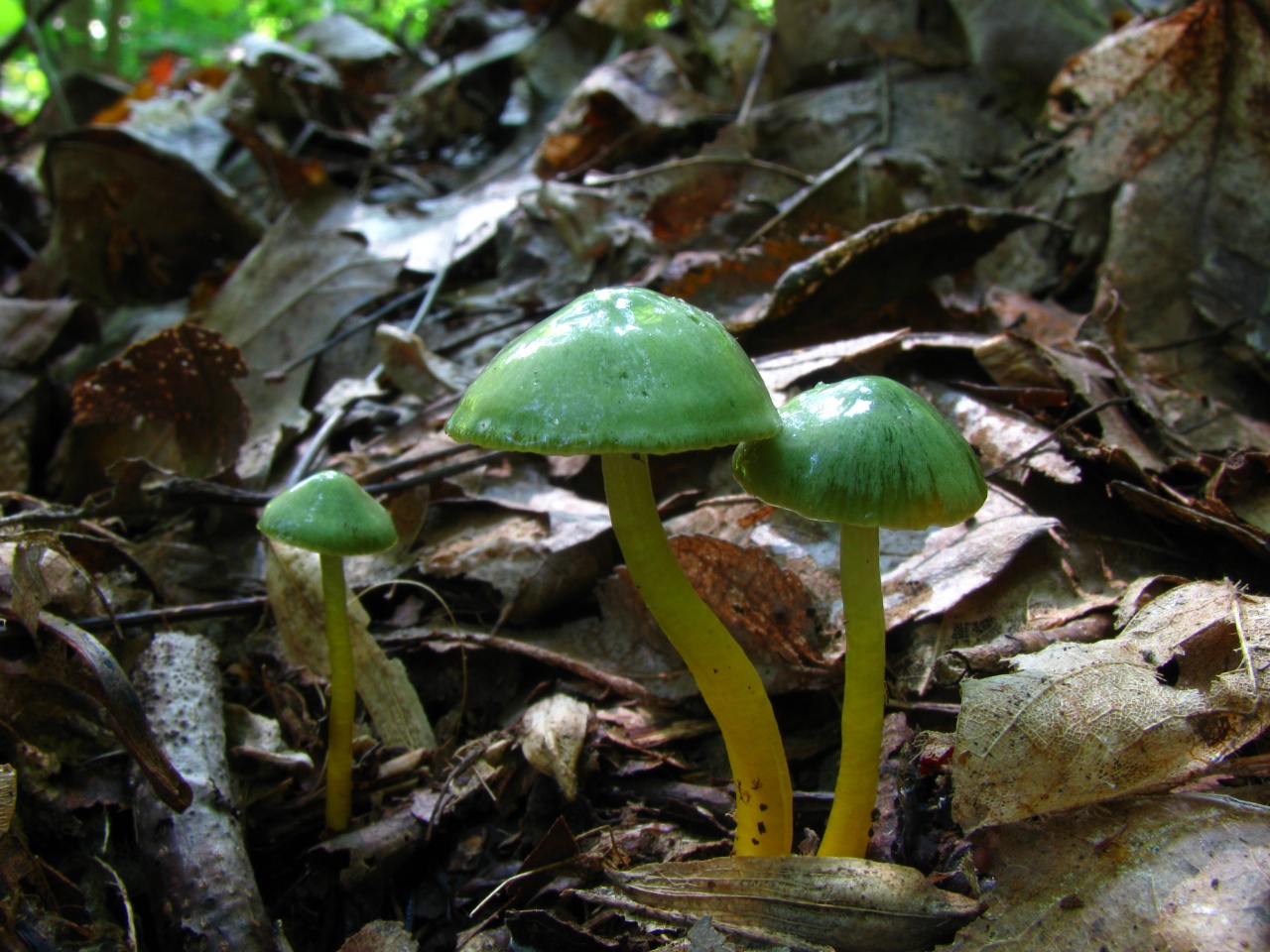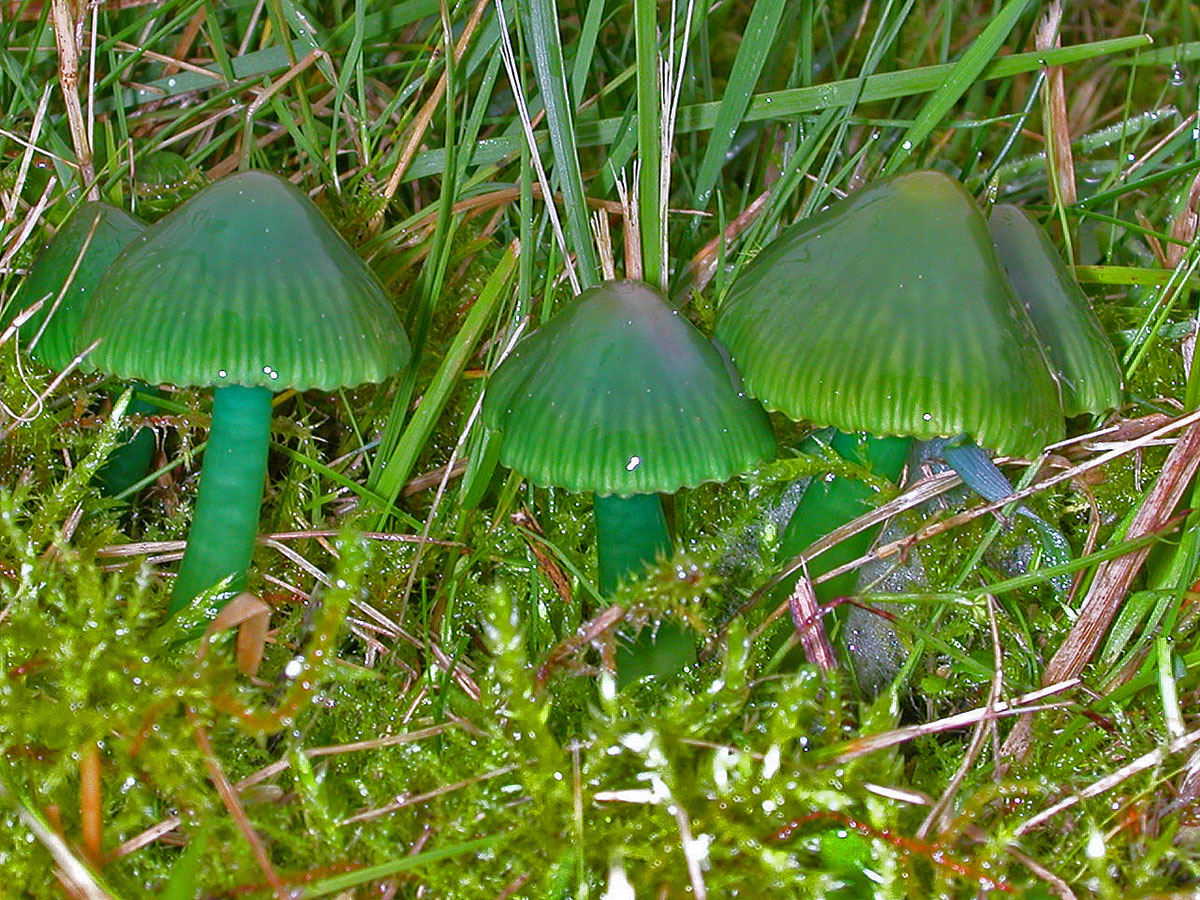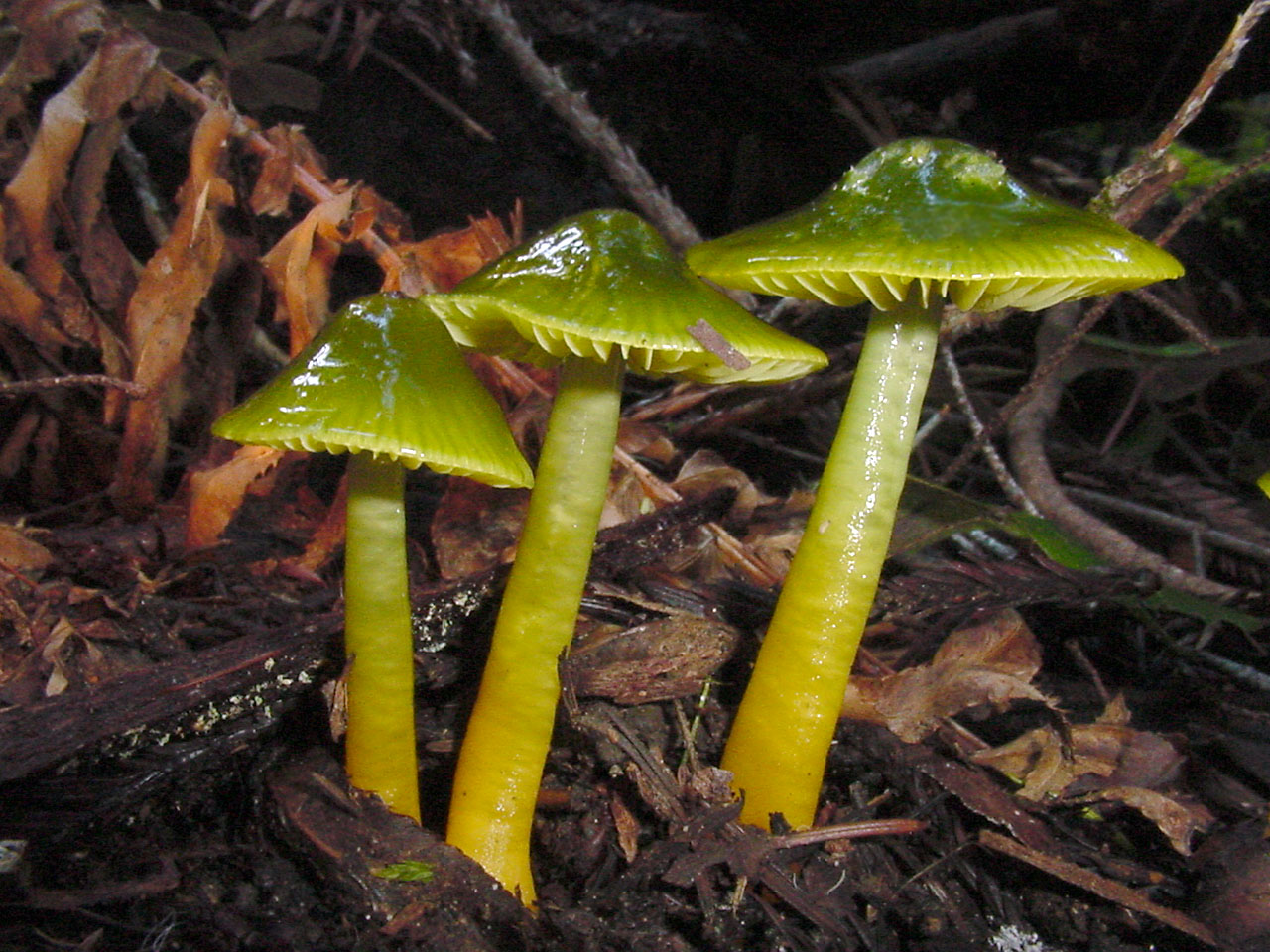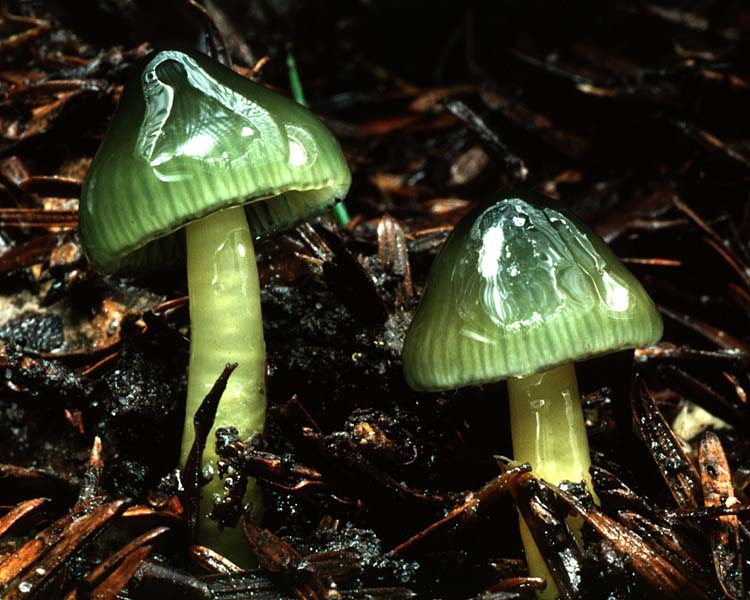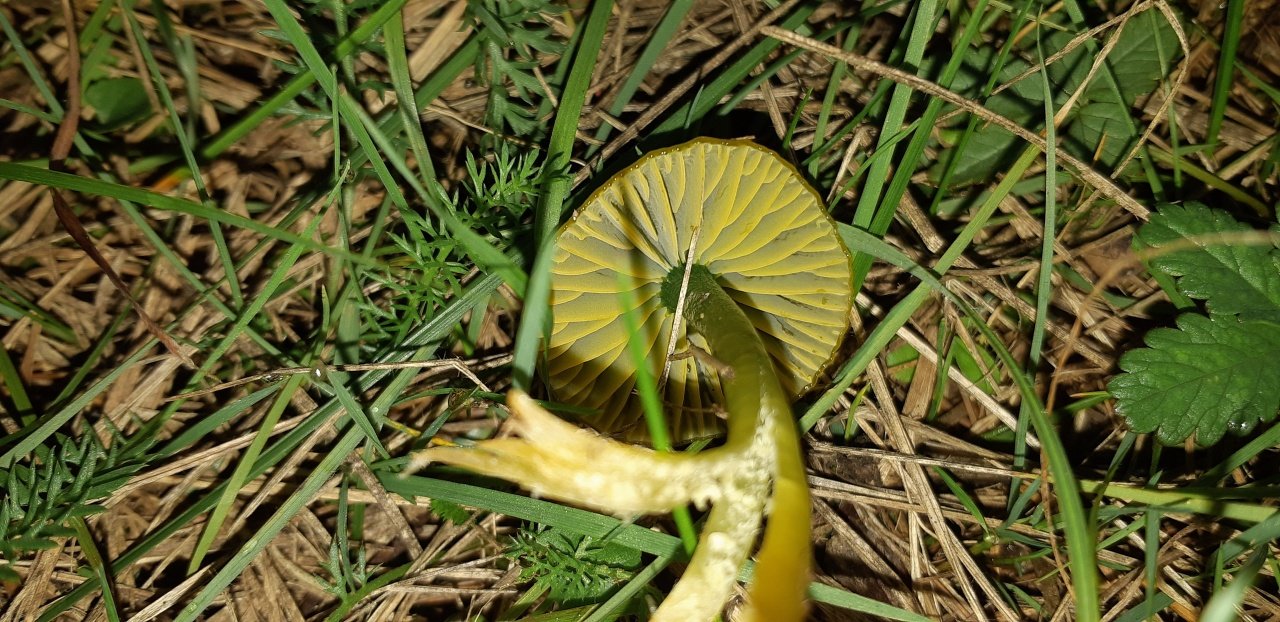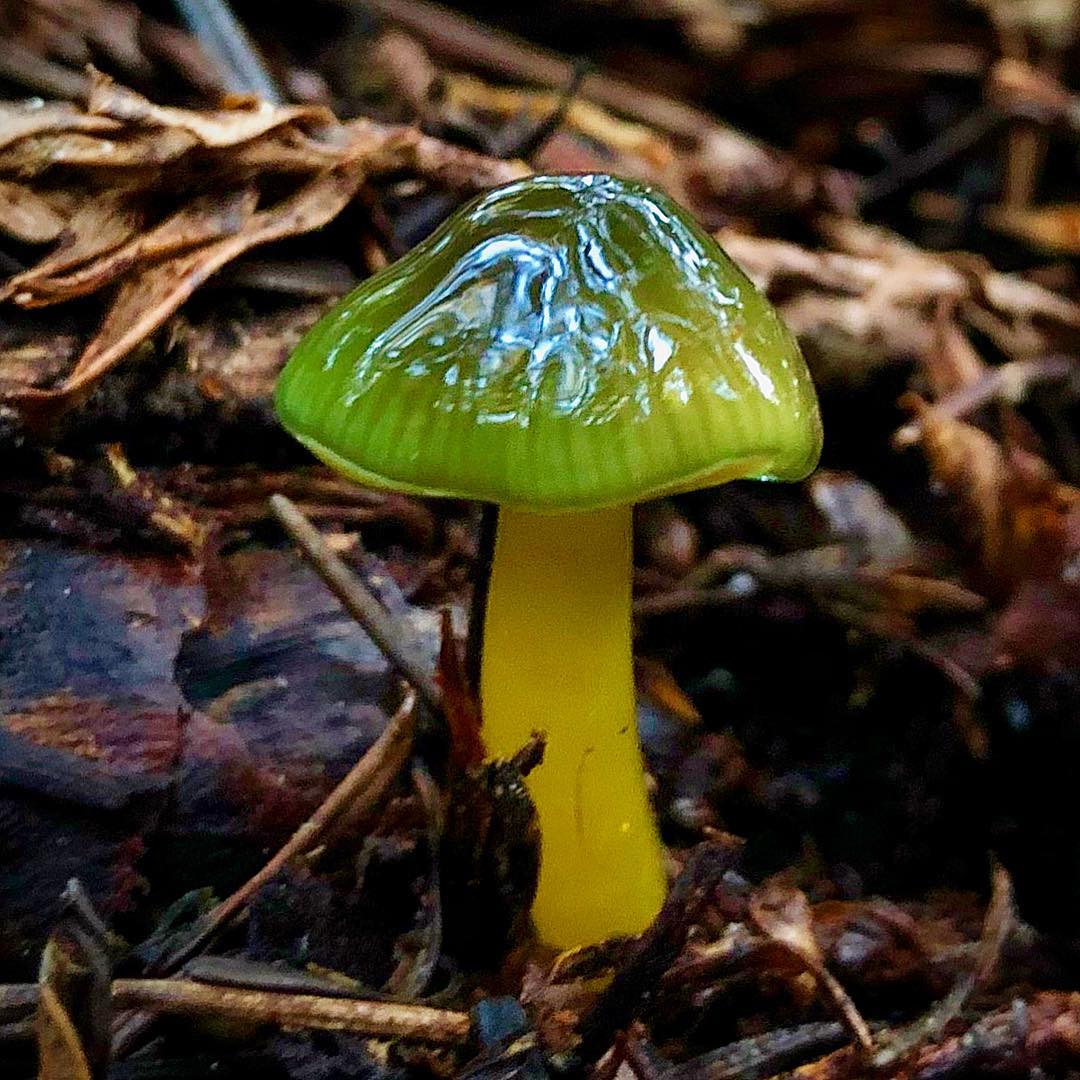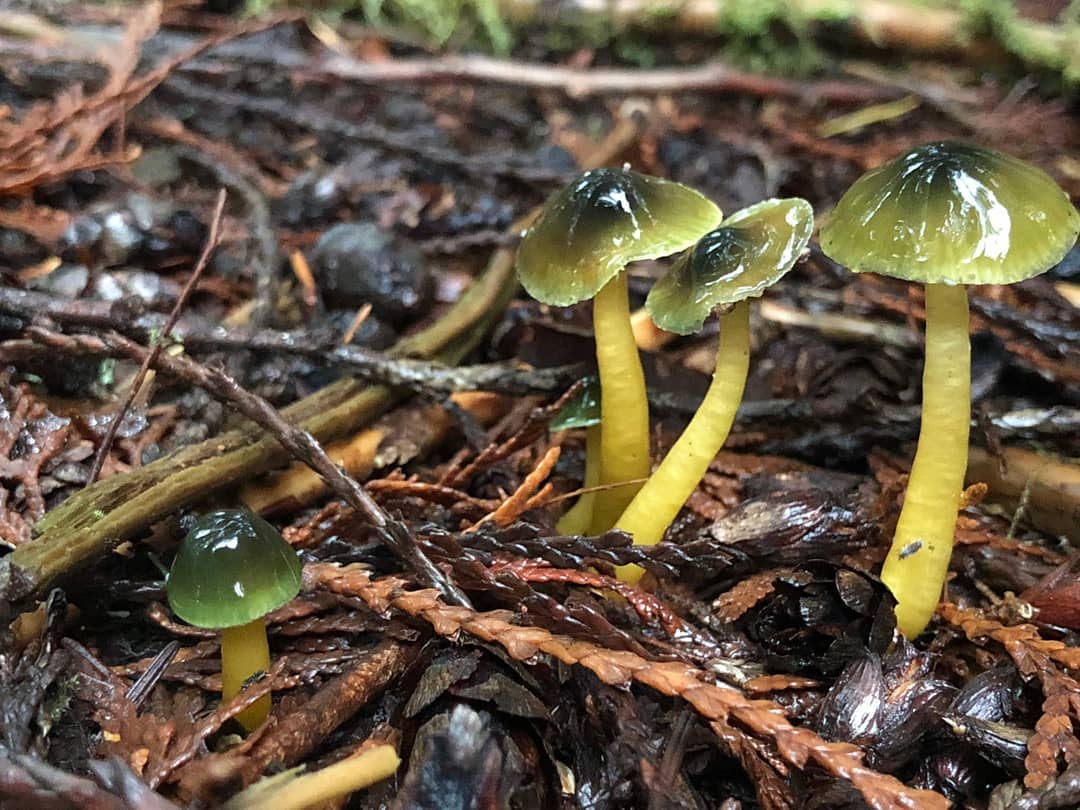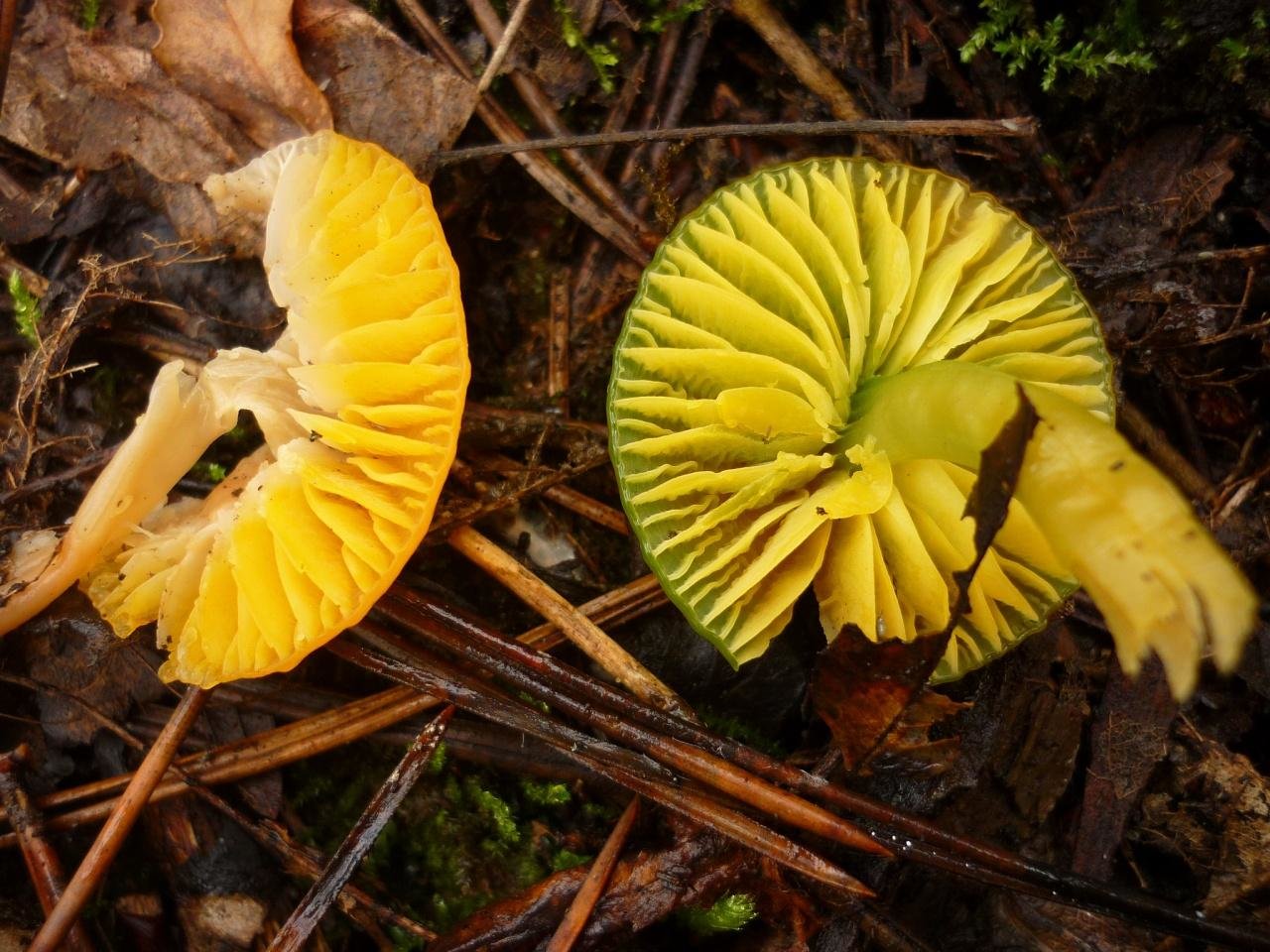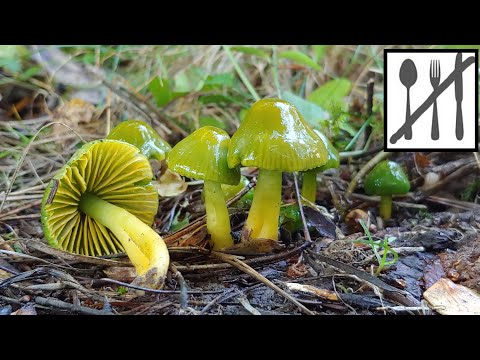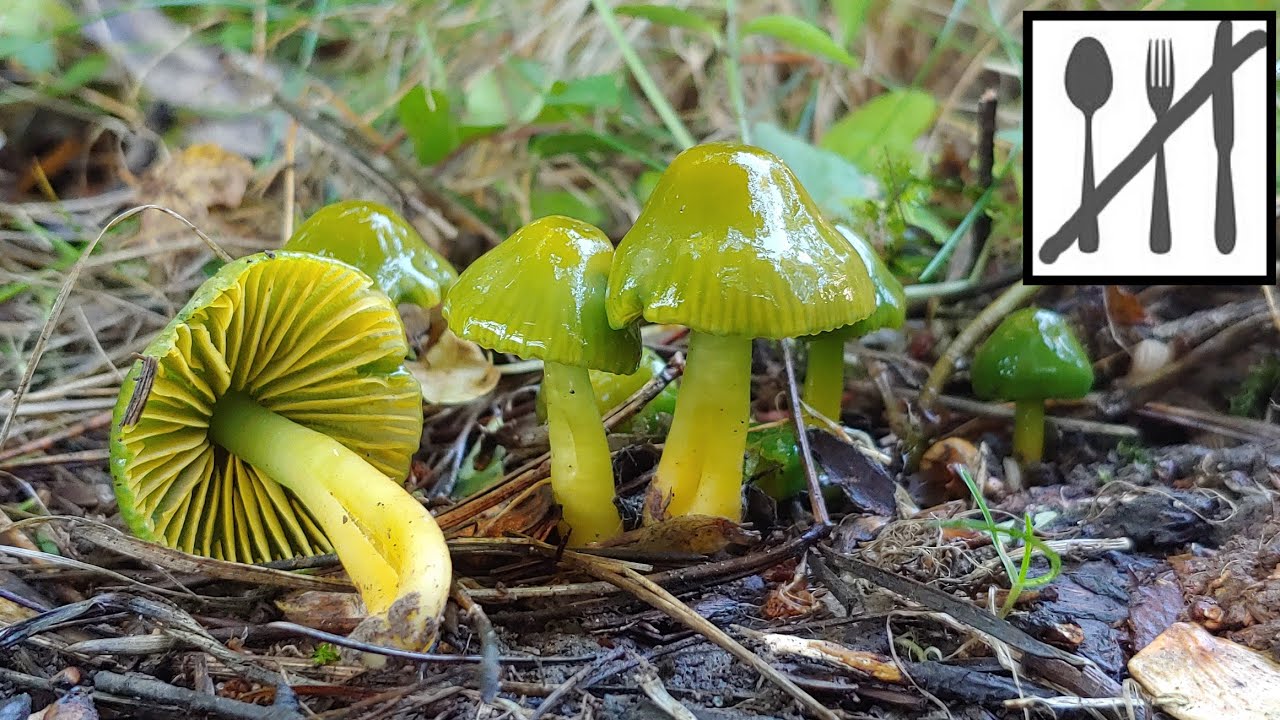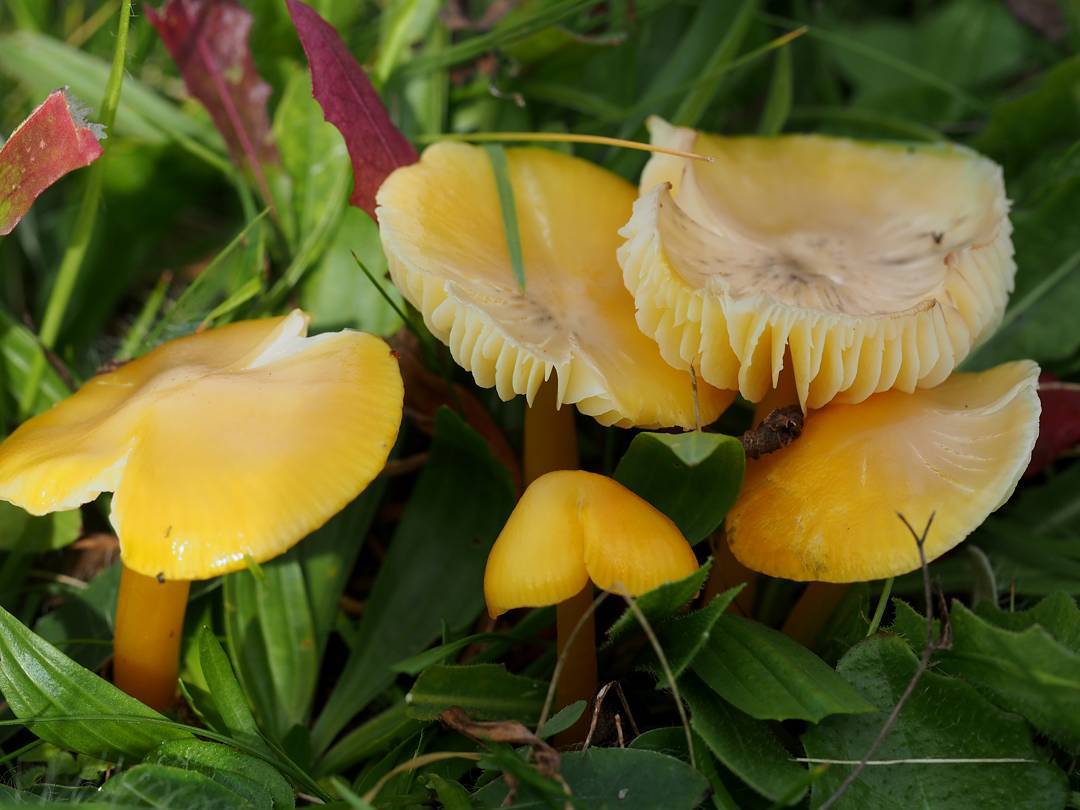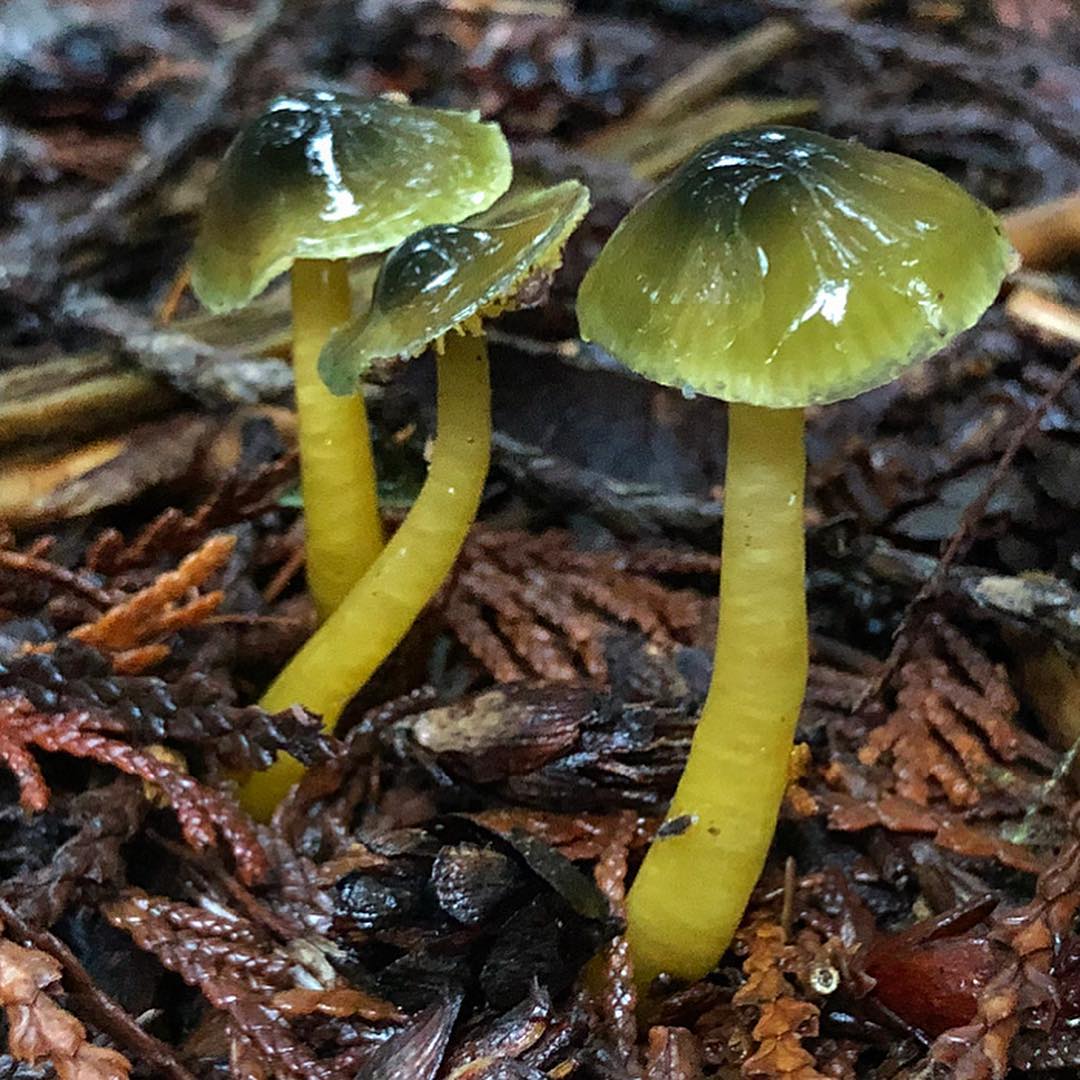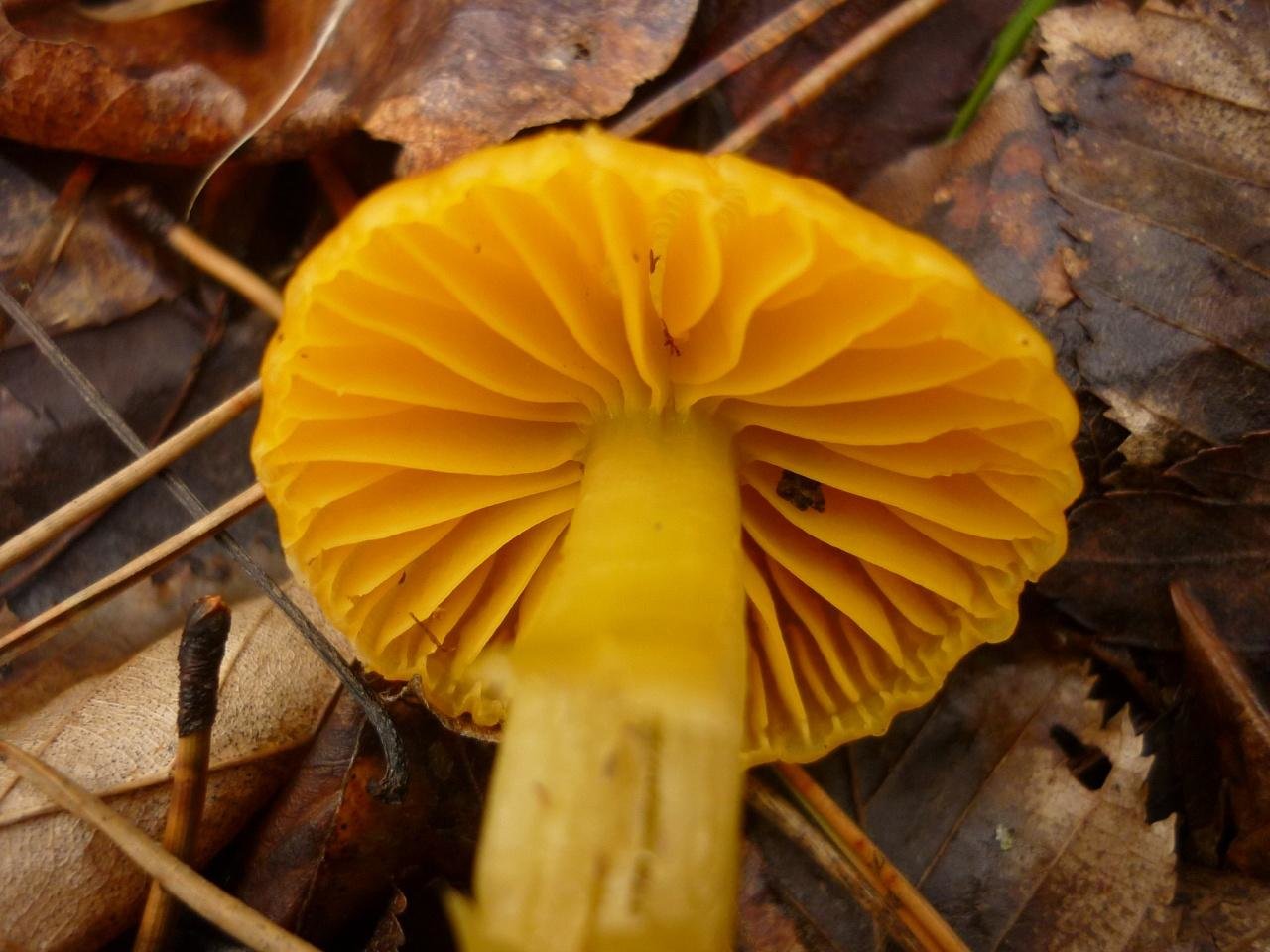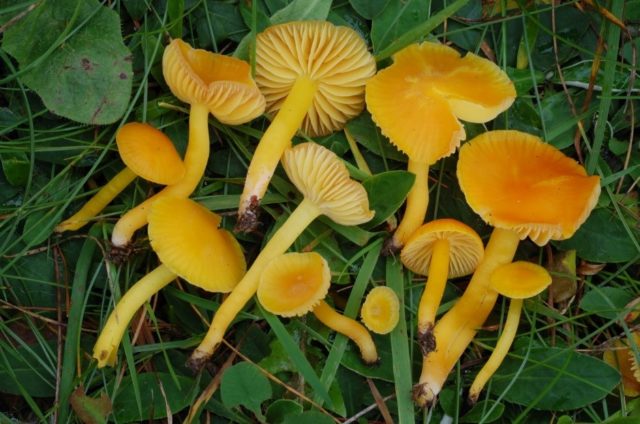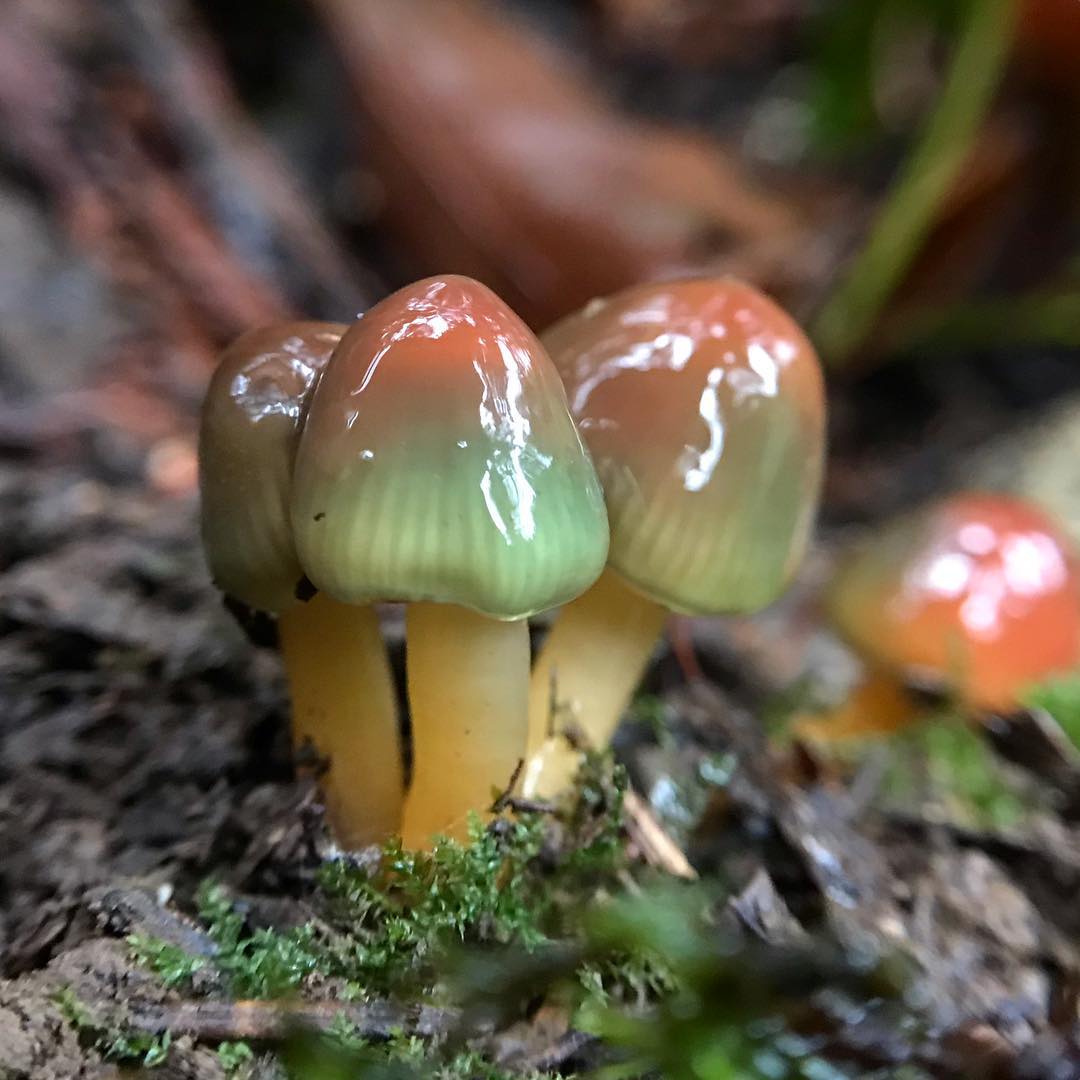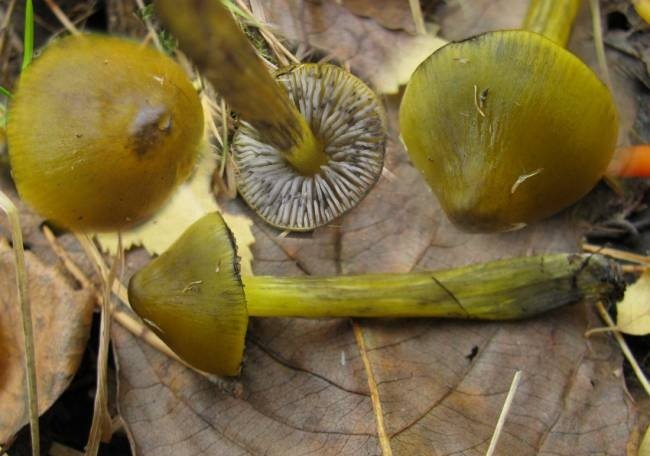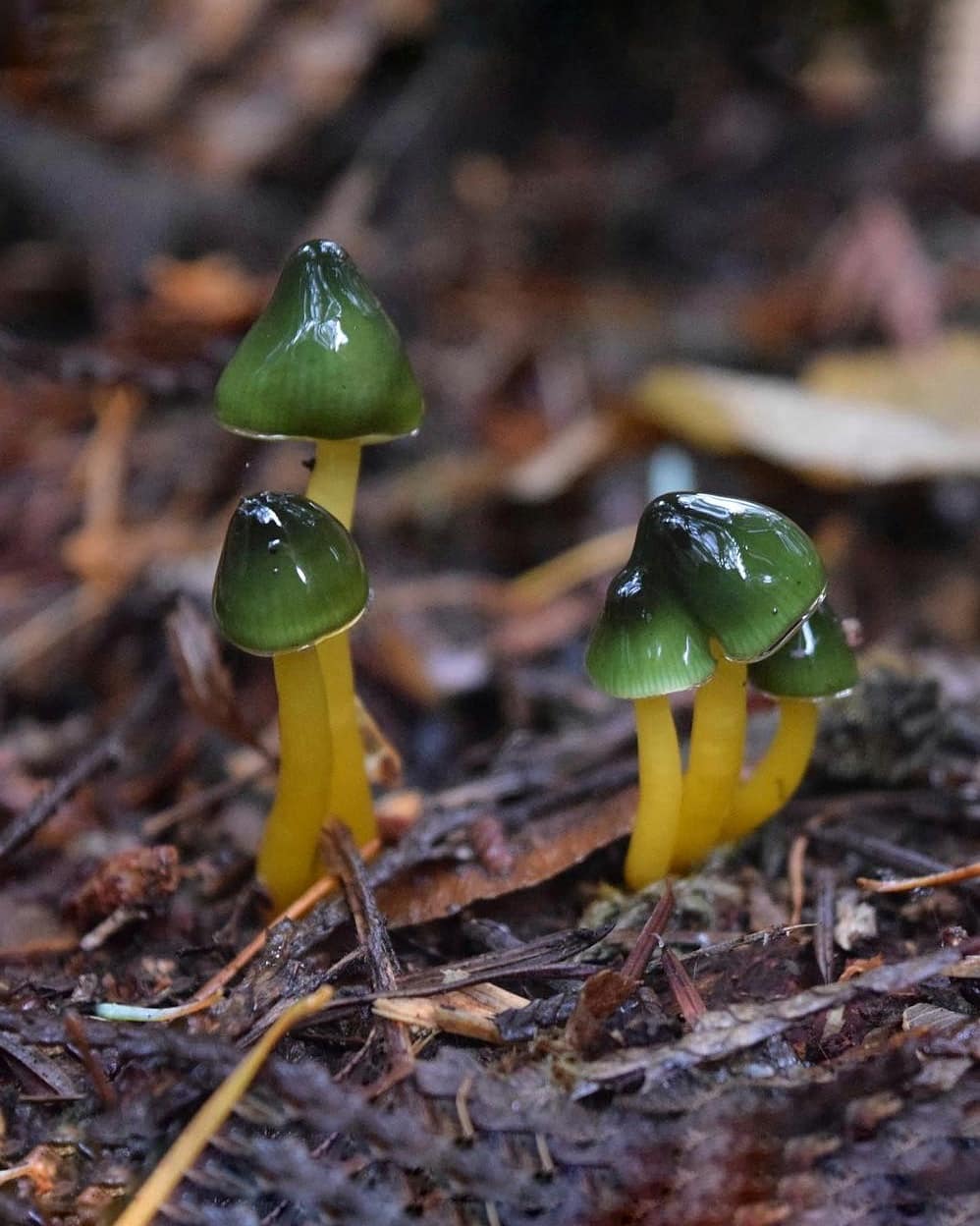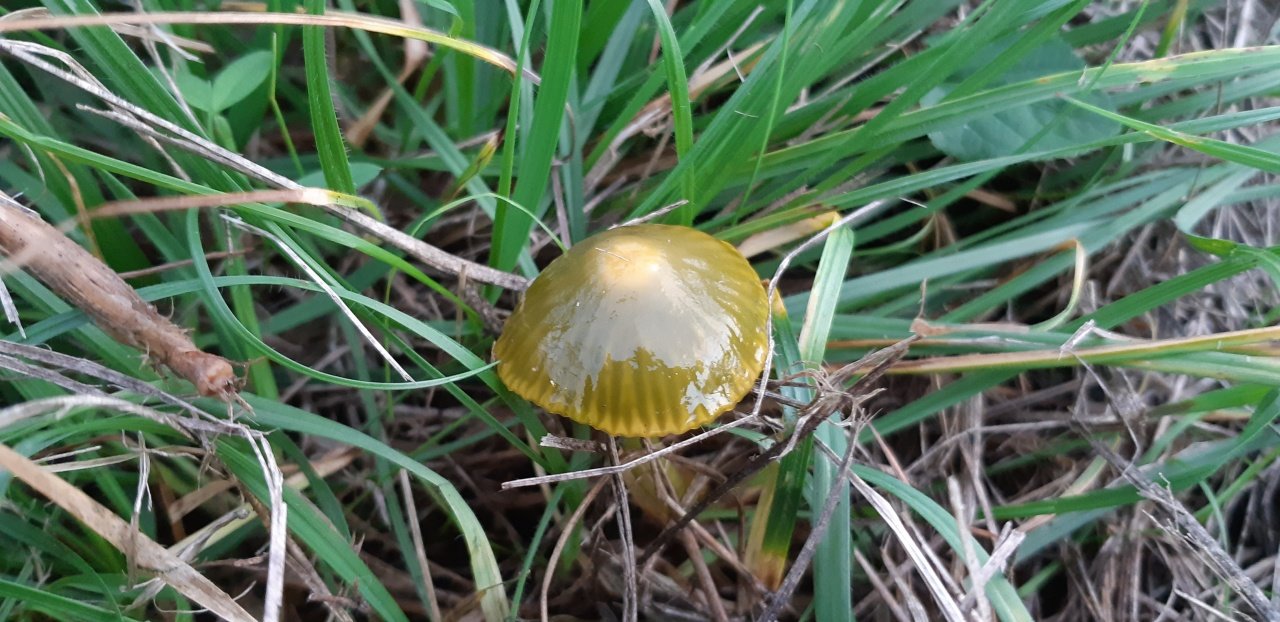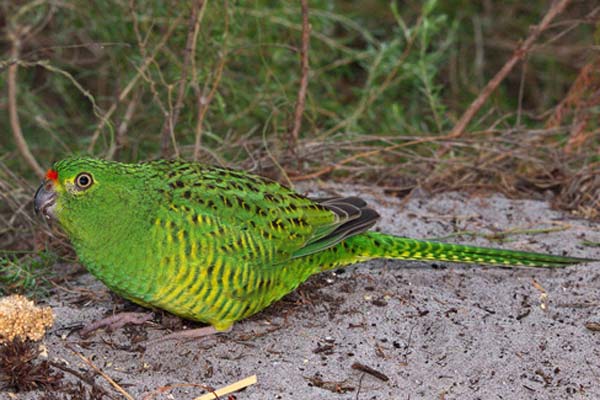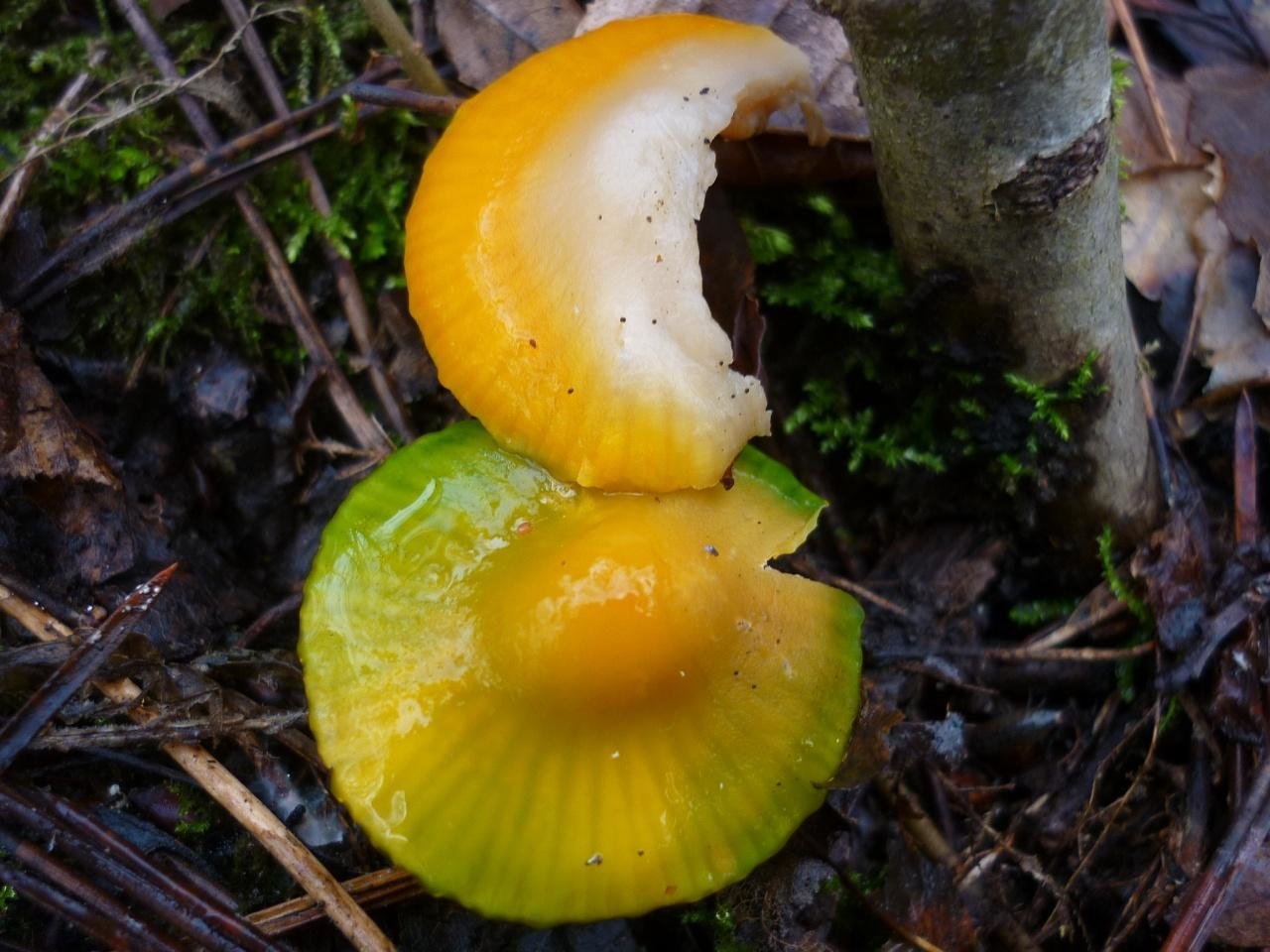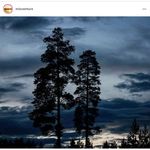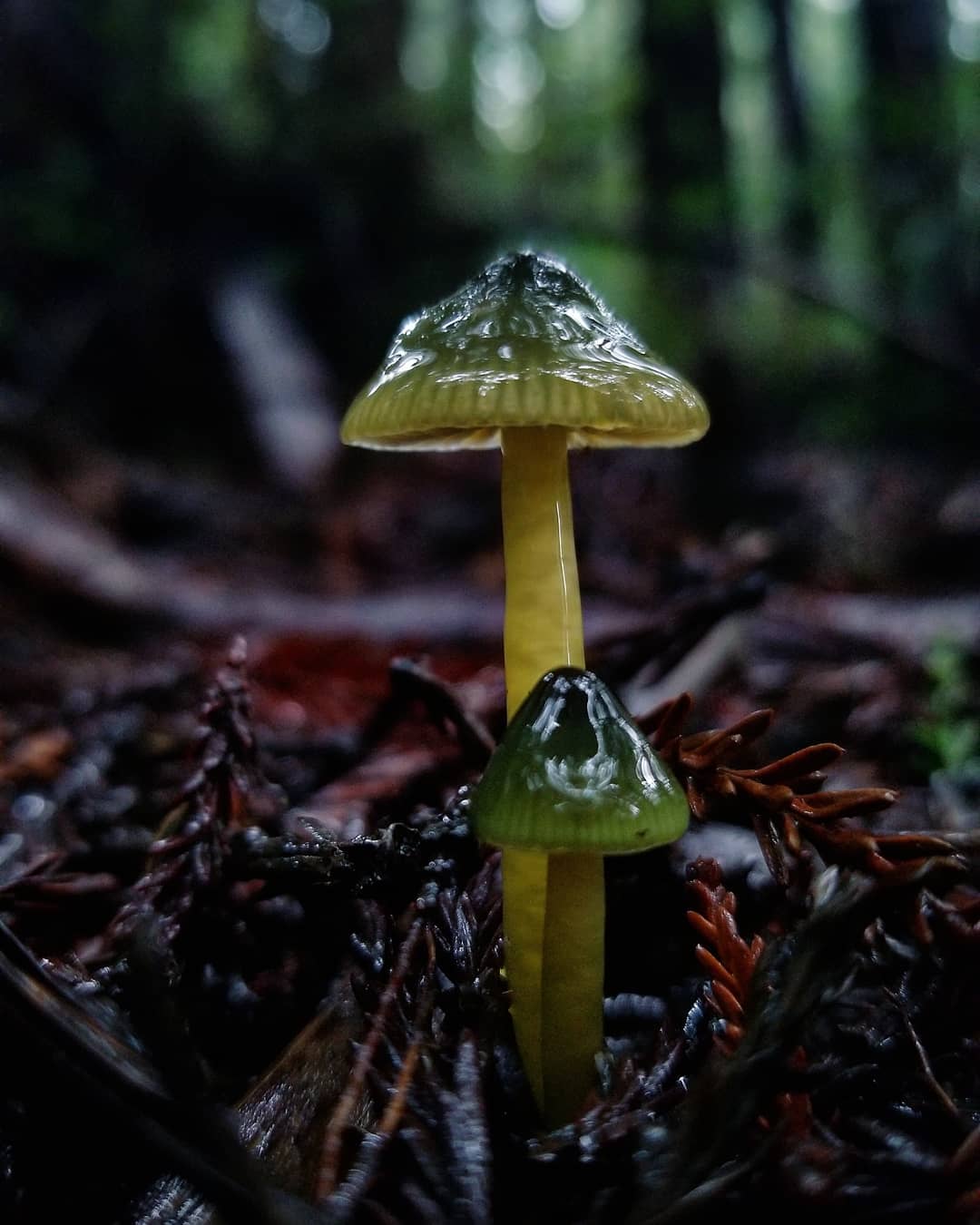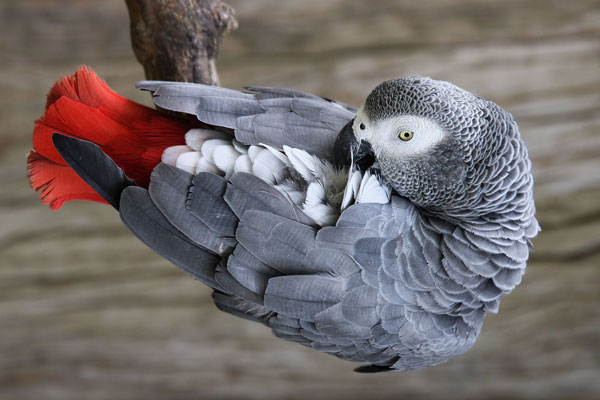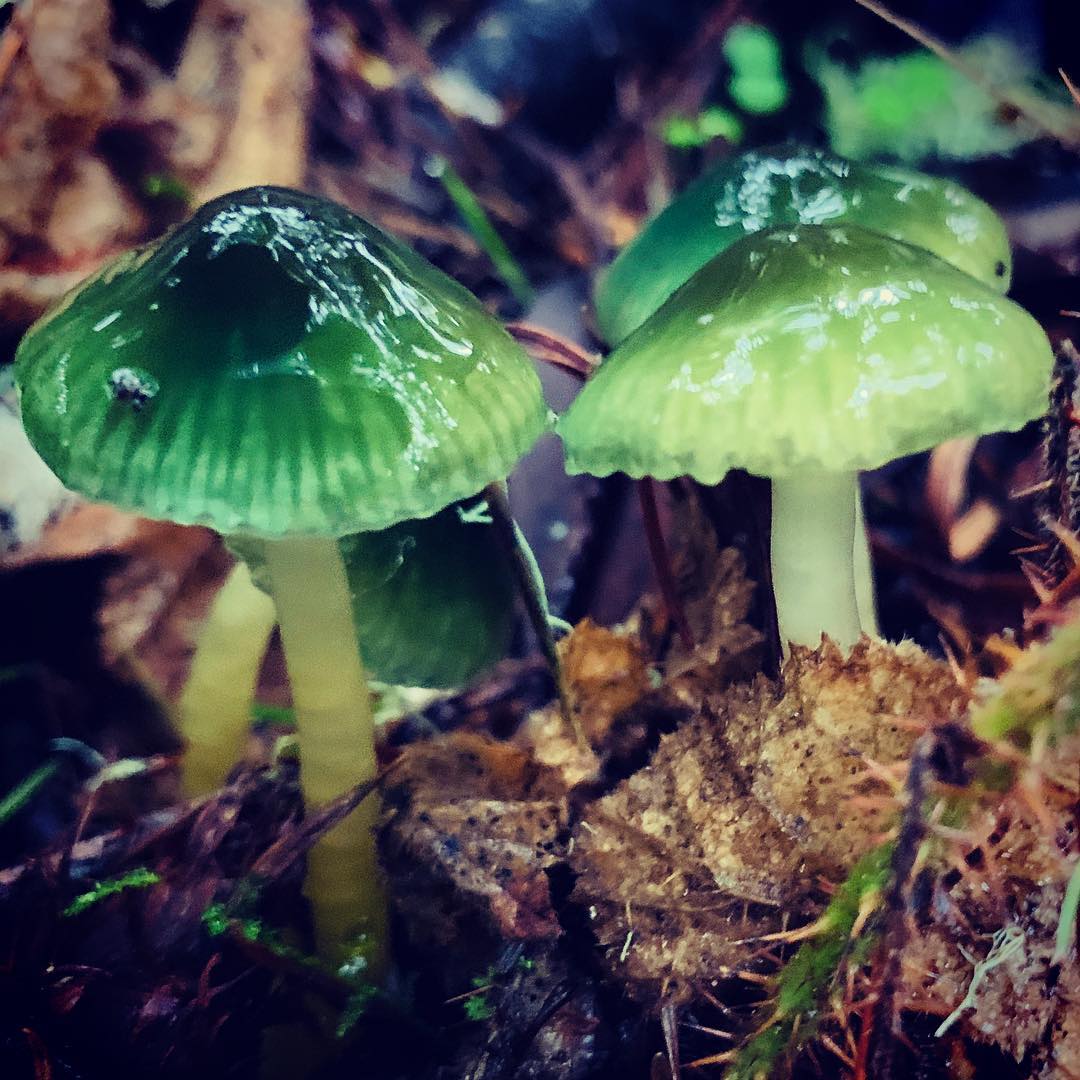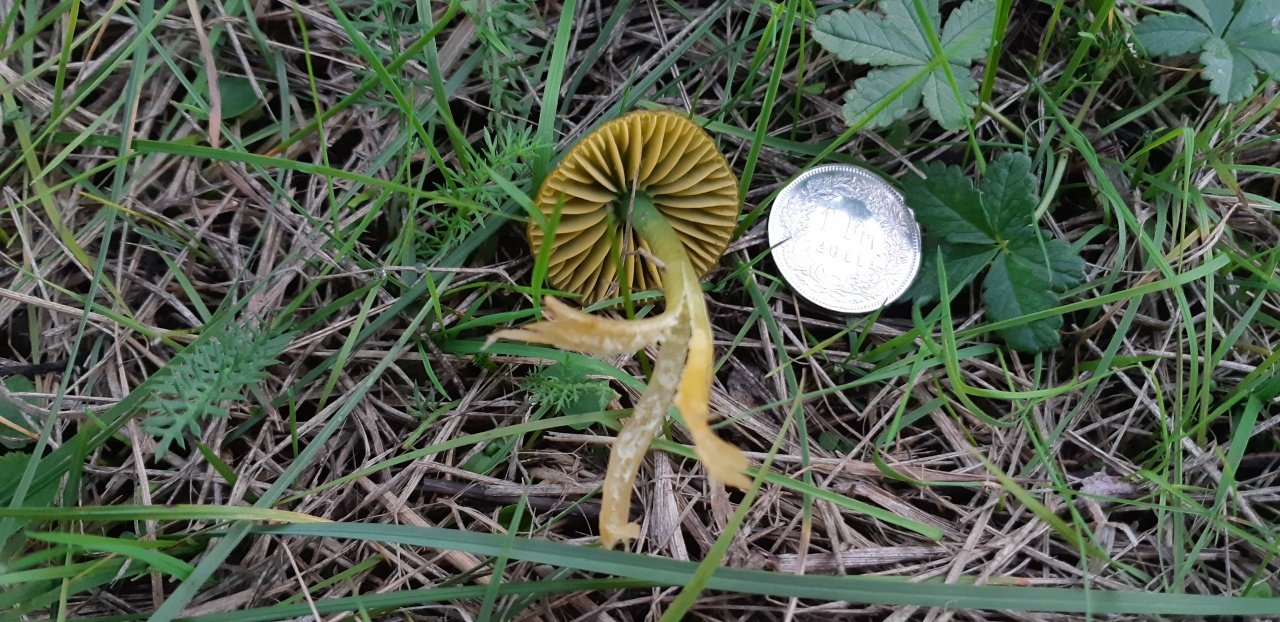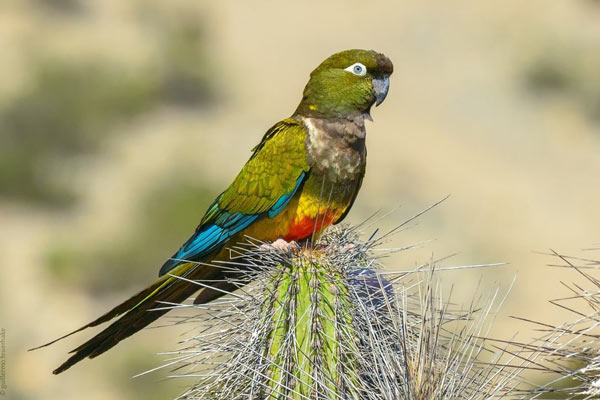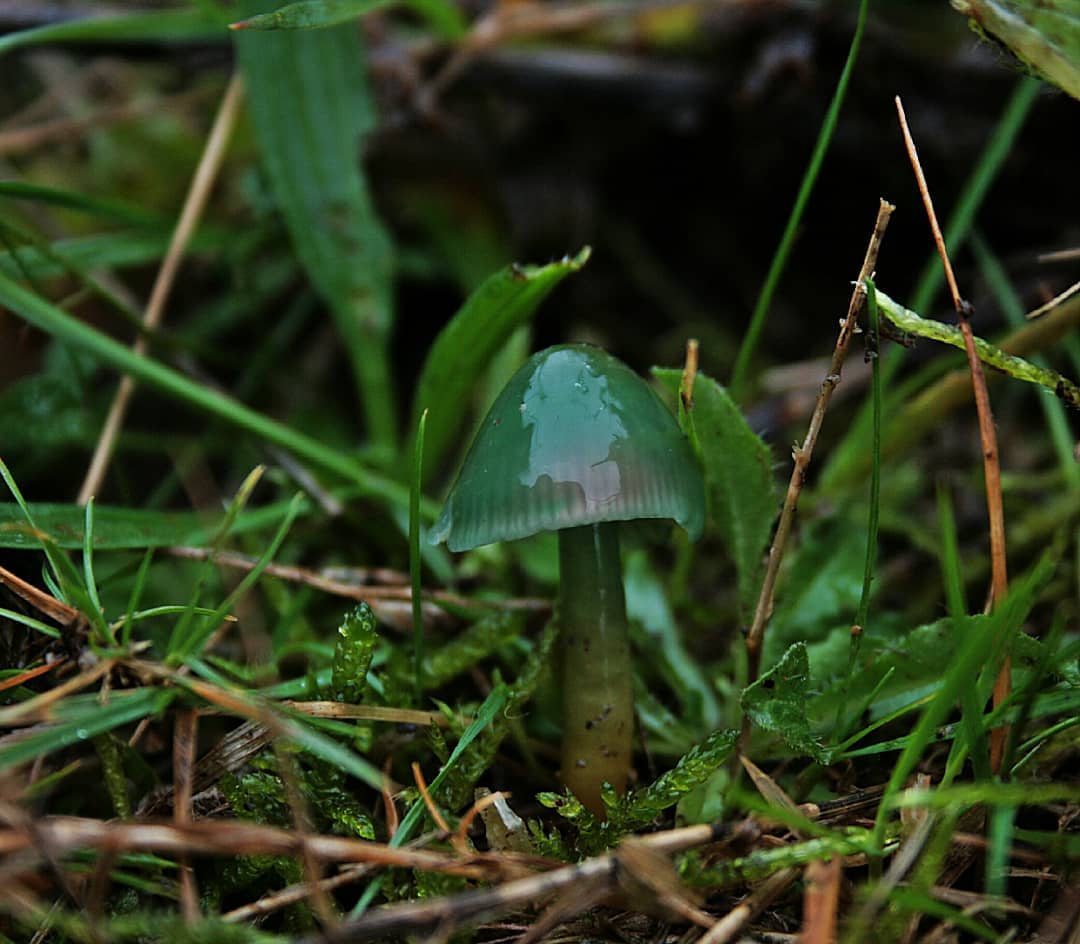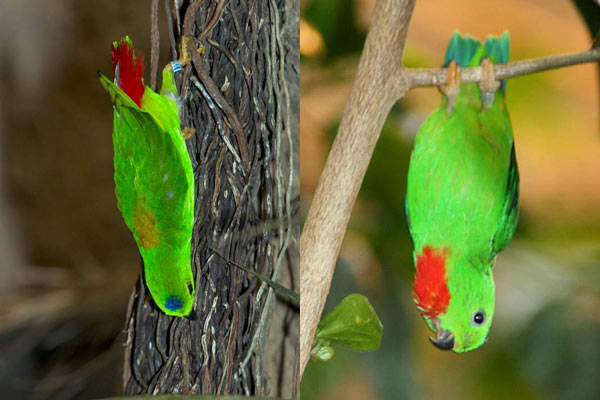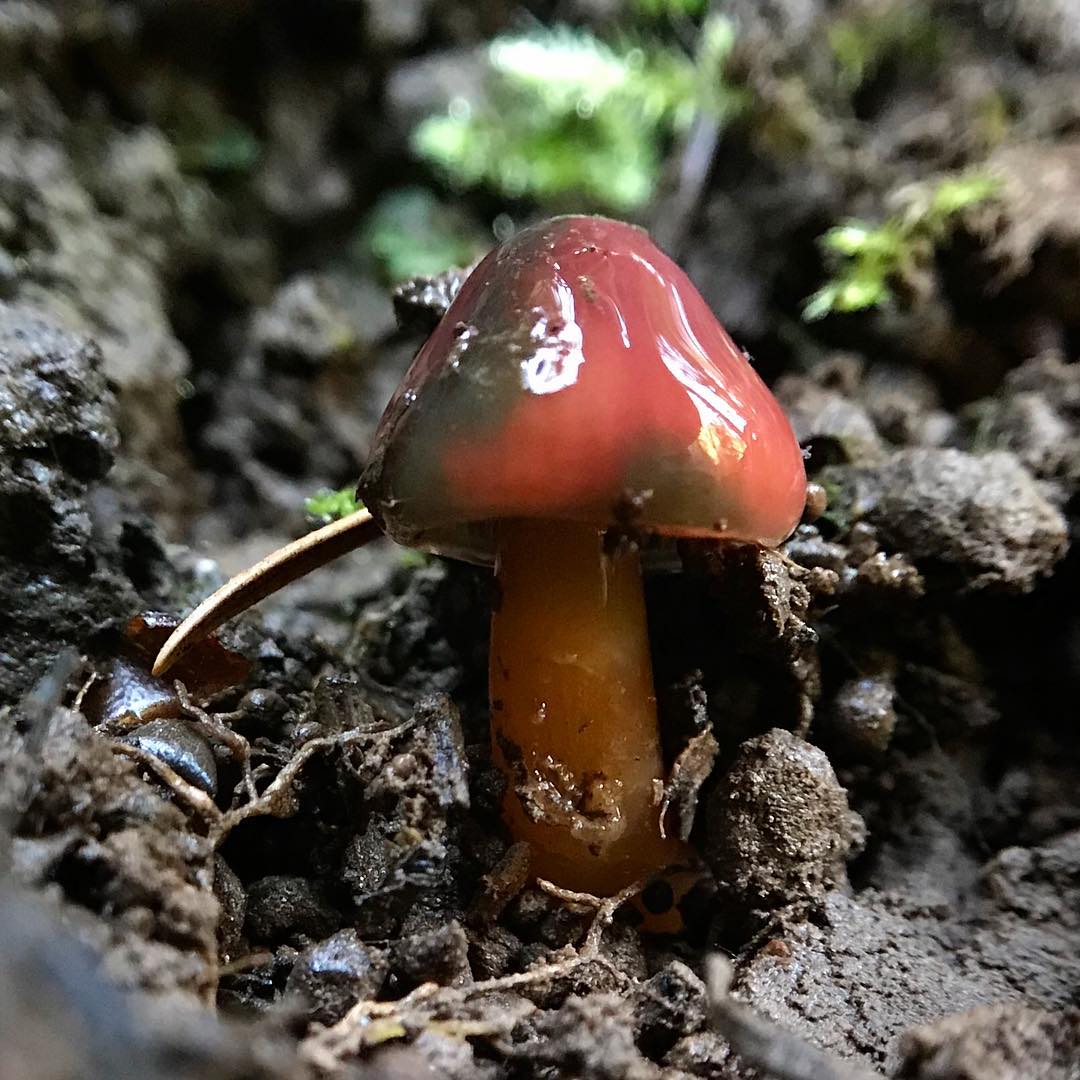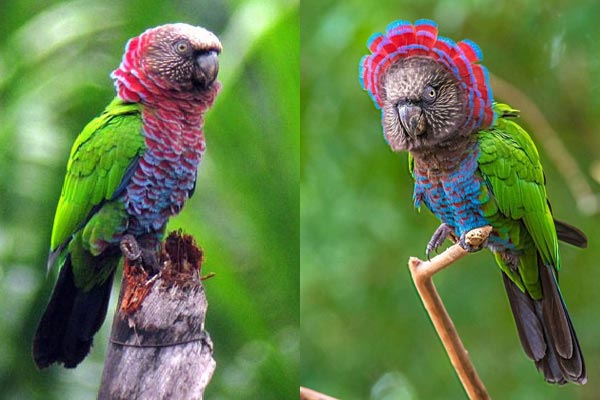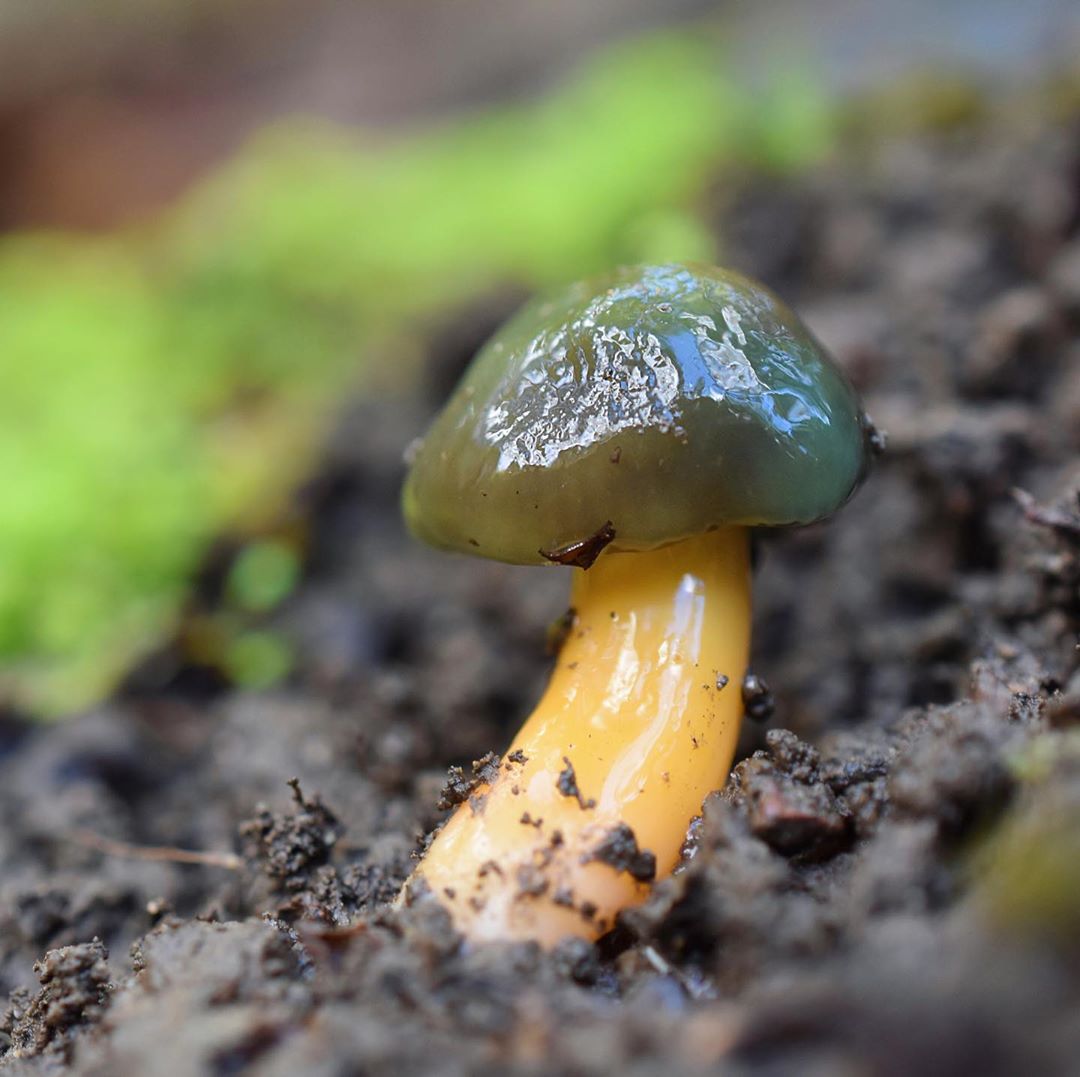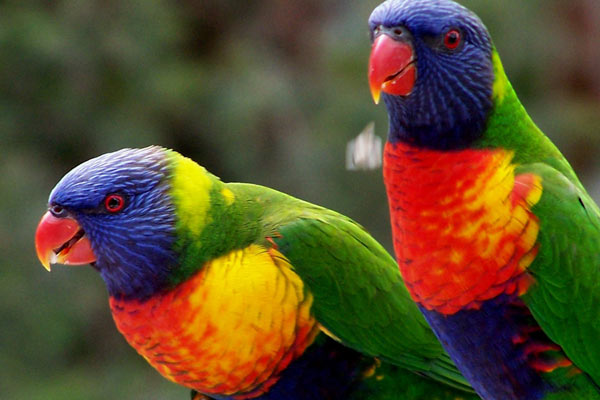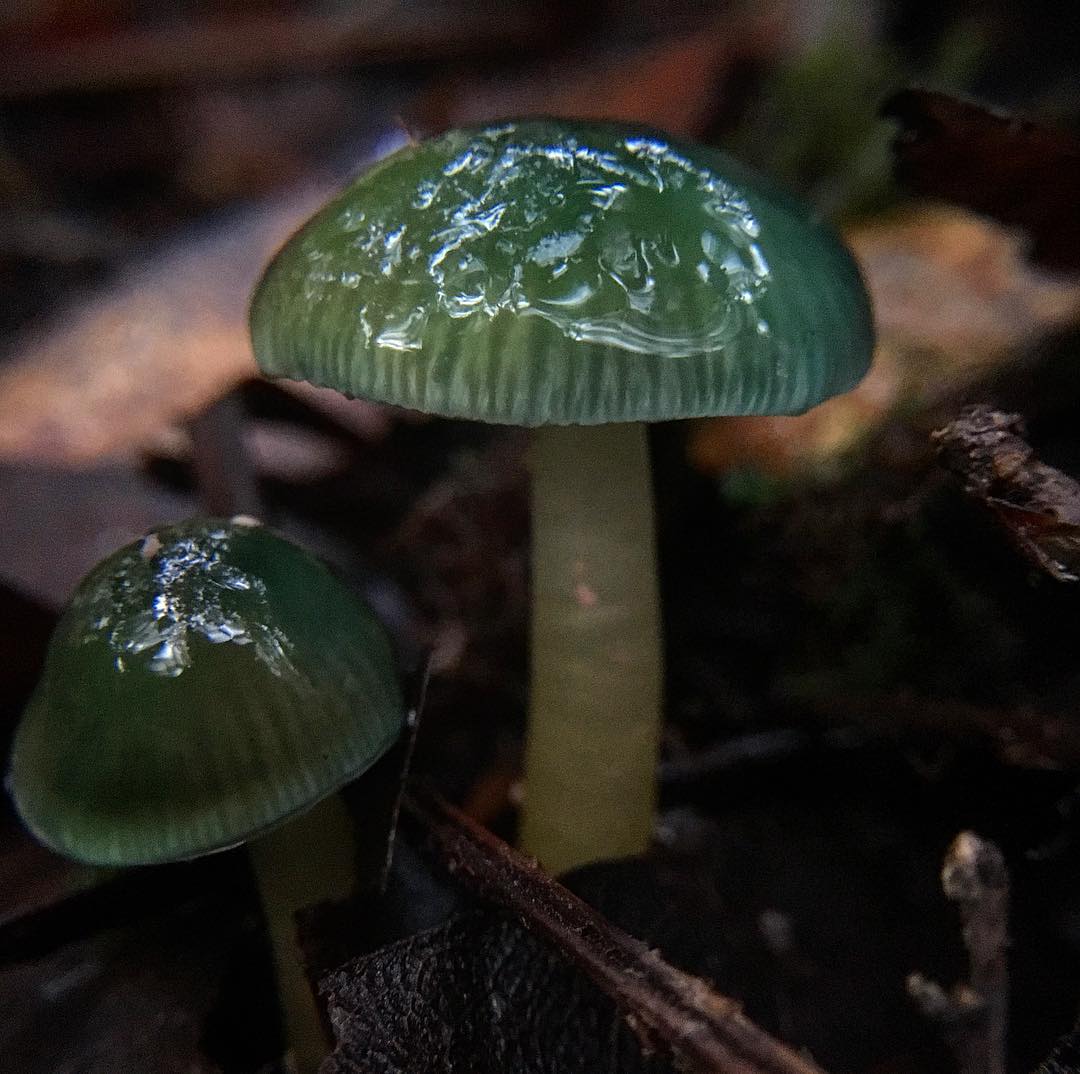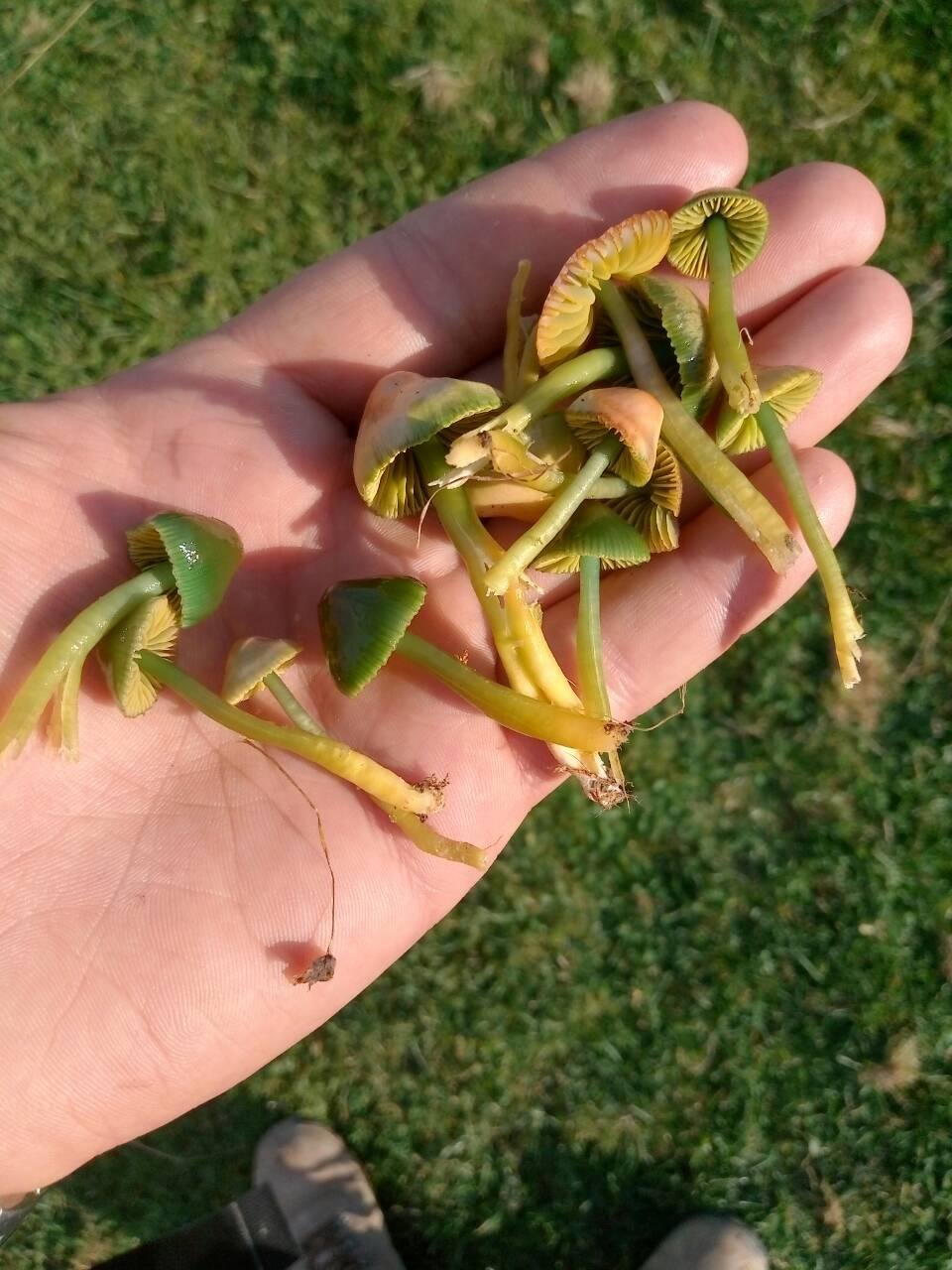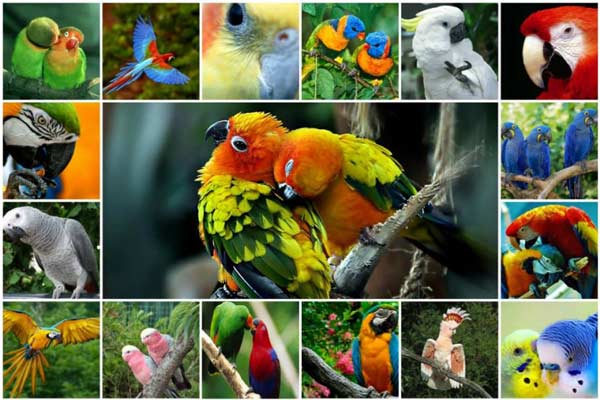Types of mushroom hygrophor
Fragrant, aromatic, or fragrant hygrophorus (Hygrophorus agathosmus)
An edible mushroom with a fleshy fruiting body. The hat is 4-8 cm in diameter, convex in shape, gradually becomes flat-convex, the edge is tucked up, the surface is sticky and slimy, especially at high humidity. The color of the cap is gray, yellowish brown or off-white, rarely with a green tint. The plates are rare, grow to the stem, white. The flesh is whitish or pale gray in color, soft, with a strong aroma reminiscent of bitter almonds, celery or anise, and a bland taste. The length of the leg is 4-10 cm, the thickness is 0.6-1.5 cm. The leg is central, cylindrical, dry or wet, the surface is not mucous. The color of the leg is white, gradually turning gray. Spores are white.
Grows from August to September in coniferous and mixed forests. Widespread in temperate climates.
Hygrophorus yellowish white (Hygrophorus eburneus)
Edible mushroom, also known as ivory wax bonnet and cowboy handkerchief. Found in Europe, North America, North Africa.
The fruit body is white. In wet weather, the hat becomes covered with a thick layer of mucus. Feels like wax.
Early hygrophorus (Hygrophorus marzuolus)
A rare species, which is also found under the names of the hygrophor of March and snow mushroom. The diameter of the cap is 4-10 cm, the structure is thick, fleshy, the shape of the young mushroom is convex, flattens with age. The surface is curved, the edges are wavy. The skin is smooth, dry, slightly pubescent. In young mushrooms, the cap is light gray or whitish, in mature ones it is lead-gray or blackish with spots. The pulp is dense, white, turns gray with age. The aroma is weak, pleasant, the taste is not expressed. The leg is 3-8 cm long, 1.5-4 cm wide, cylindrical, curved, solid, thinning downwards. The color is whitish or gray, with a silvery tint. Spores are white.
Unlike other hygrophors, the species is very early, appears in March and grows until the beginning of May. It is found in coniferous and deciduous forests, often under beeches.
An edible mushroom used in soups and garnishes for meat dishes. Since the March hygrophor appears very early, it cannot be confused with other mushrooms, including poisonous ones.
Hygrophorus olive-white (Hygrophorus olivaceoalbus)
The diameter of the cap is 2-6 cm, the shape is hemispherical in young mushrooms, in old ones it is convex or flat, covered with a layer of mucus. The color of the cap is gray-brown or olive-brown, darker in the center, becomes lighter as it matures. The pulp is strong, white, yellow in the center, the pulp is fibrous in the stem. Aroma and taste are poorly expressed. The stem is 4-8.5 cm long and 0.4-1.0 cm thick, central, cylindrical or fusiform, olive-brown color. Spores are white.
An edible mushroom that is eaten fresh.
It grows from August to November in coniferous and mixed forests next to spruce. Widely distributed in Eurasia.
Gigrofor russula or russula (Hygrophorus russula)
A fleshy edible mushroom that grows in the deciduous forests of the Northern Hemisphere.
The diameter of the cap is 5-12 cm, the shape is hemispherical, gradually becoming convex, flattened, the edge is turned up. The surface is smooth, in wet weather it becomes sticky-mucous, in young mushrooms it is whitish or pinkish in color, with pink spots, then it becomes pink-red and in a mature mushroom - wine-red. The pulp is dense, white, pinkish on the cut, the smell is weak, flour, the taste is not pronounced. The leg is 6-8 cm long, 1-2.5 cm thick, central, tapering downward, clavate or fusiform, white with pinkish-brown spots. Spores are white.
Edible mushroom, used fresh, pickled or salted. It is considered the best in taste of all species of the family.
It grows from August to November in deciduous and mixed forests, next to an oak tree.
Beneficial features
The use of these mushrooms will allow you to establish metabolism, improve the functions of the thyroid gland, digestive, immune systems, and normalize well-being.
The beneficial effects of the hygrophor are as follows:
- normalizes the digestive tract - food is absorbed through the intestinal walls, intestinal motility is normalized, the mucous membrane gains elasticity;
- blood microcirculation accelerates - neutralization of inflammatory processes;
- control of acid-base balance - the lymphatic system works better, wrinkles are smoothed, aging slows down;
- prevents the development of diabetes mellitus;
- improves kidney and liver function;
- tones the body - stimulates metabolism, develops resistance to inflammatory processes;
- helps to fight overweight;
- sedative property - nervousness decreases.
For the composition of representatives of the genus, the presence of amino acids and vitamins A, C, D, PP and group B is characteristic. The amount of protein is not inferior in this indicator to meat. Also, the presence of sodium, sulfur, potassium, manganese, calcium, iodine and zinc was determined in the composition of the mushrooms.
Hygrophorus late (Hygrophorus hypothejus)
Gigrofor brown
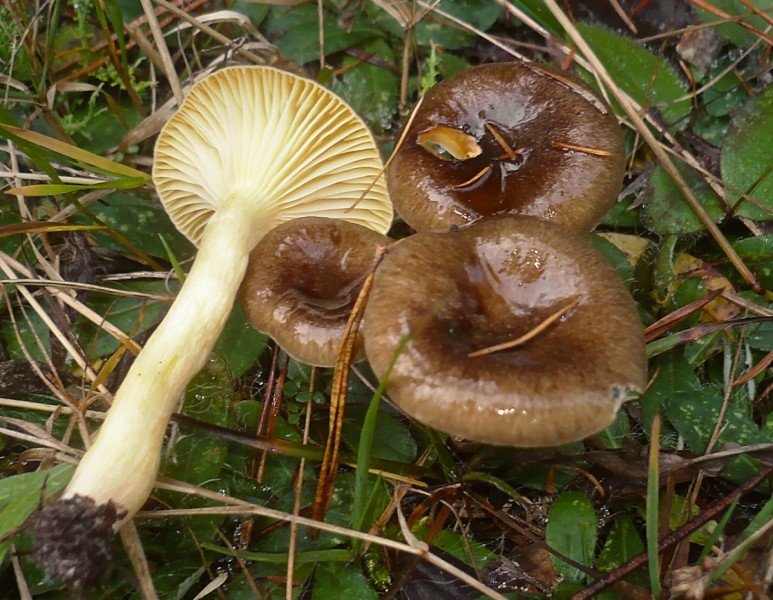
The cap of the late Gigrofor: 2-5 cm in diameter, in young mushrooms it is flat or slightly convex, with tucked edges, with age it acquires a funnel-shaped shape with a characteristic small tubercle in the center. The color is yellow-brown, often with an olive tint (especially in young, well-moisturized specimens), the surface is very slimy, smooth. The flesh of the cap is soft, whitish, without any special smell or taste.
Plates: Yellowish, rather sparse, forked, deeply descending along the pedicle.
Spore powder: White.
Leg of Gigrofor late: Long and relatively thin (height 4-10 cm, thickness 0.5-1 cm), cylindrical, often sinuous, solid, yellowish, with a more or less mucous surface.
Distribution: Gigrofor late occurs from mid-September to late autumn, without fear of frost and first snow, in coniferous and mixed forests, adjacent to a pine tree. It often grows in mosses, hiding in them up to the very cap; at the right time can bear fruit in large groups.
Similar species: Of the widespread species, the late white-olive hygrophorus (Hygrophorus olivaceoalbus) is similar to the late Hygrophorus olivaceoalbus, slightly similar to Hygrophorus hypothejus, but it has a characteristic striped leg. How many small late hygrophors actually exist, hardly anyone knows.
Edible: Brown Gigrofor - quite edible, despite its small size, mushroom; the special time of fruiting gives it great value in the eyes of the purveyors.
Video about the mushroom Gigrofor late:
Remarks What this small but glorious hygrophor has gotten attention to is that it doesn't seem to mind being harvested at all. Judge for yourself
First, Gigrofor is late in itself, grows deep in mosses, but for some reason it is perfectly visible, including from afar. And secondly, it easily separates from the base along with a long, winding leg, but without further consequences, as if someone had carefully disconnected it from the mycelium inside. It's nice to see a mushroom so open to cooperation; one can only hope that this openness is sincere and disinterested, and that no one in the end will have to regret.
Mushroom photo Gigrofor late from questions in recognition:
Description of the fragrant hygrophor.
The cap of the fragrant hygrophor is at first convex, but later transforms into a prostrate one, with a central tubercle. Its diameter is 3-7 centimeters. The cap is covered with a smooth, slimy skin. The color of the cap is grayish, yellow-gray or olive-gray. The edges of the cap are distinguished by a lighter shade; they remain wrapped inward for a long time.

There are thick and soft plates under the head. The shape of the plates can be forked.In young specimens, the plates are adherent, and in old ones they descend to the leg. At a young age, the color of the plates is whitish, and later it changes to a dirty gray. Spore powder is white.
The stem of the fragrant hygrophor is cylindrical, thickened in the lower part, sometimes flattened. Its height reaches 7 centimeters, and the girth is about 1 centimeter. The color of the leg is grayish or brown-gray. The surface of the leg is covered with small flakes resembling flakes.

The flesh of this mushroom is soft, in wet weather it becomes watery and loose. The color of the pulp is white. The pulp has a distinct almond aroma, and it tastes sweet. After the rain, a group of fragrant hygrophors emits an aroma so strong that it spreads for several meters. It is due to its smell that the fragrant hygrophor differs from other members of the family.
Places of growth of fragrant hygrophors.
Fragrant hygrophors grow in spruce forests, they can be found in damp and mossy places. These mushrooms prefer mountainous areas. Fragrant hygrophors bear fruit from summer to autumn.

Evaluation of the edibility of a fragrant hygrophor.
This type of mushroom is practically unknown, but it is suitable for eating fresh, salted and pickled.
During the preparation of fragrant hygrophors, it is necessary to remove the mucous skin, since it has an unpleasant taste and can ruin the dish. Despite this, the scented hygrophors are tender, fleshy and tasty.

Botanical description and species
The hygrophor is a lamellar mushroom belonging to the rare hygrophoric family. More than forty different species of this plant are known. All of them belong to mycorrhizal fungi, that is, they grow near trees and grasses, forming a common root system with them. The most common are early, late, brown, fragrant, russula and olive-white hygrophors.
Gigrofor white. This mushroom grows in autumn, forming large colonies. Appears in September and bears fruit until the end of October.
His hat is convex, white. Over time, it turns yellow and evens out. The diameter can vary from two to eight centimeters. If the weather is humid, mucus forms on the surface, which disappears on sunny days. The pulp is white, with a slight bitterness, odorless. The leg is high, cylindrical in shape, the same color as the cap.
It is an edible mushroom, but it is not popular with mushroom pickers.
Gigrofor aromatic (fragrant, fragrant, good). Prefers to grow in shady spruce forests, among mosses. You can find this mushroom from late summer to early November. Forms small groups, which are easy to find in wet weather due to the persistent almond-aniseed odor.
The diameter of its cap can reach 8 cm. It can be gray, gray-green or gray-brown in color. There are thick, rare gray plates under the head. The pulp is loose, white or grayish, tasteless, but with a characteristic smell of anise. The leg grows up to five centimeters in height and one centimeter in diameter, light gray in color, dense structure.
Early gigrofor. The name of this mushroom speaks for itself: it appears in the spring immediately after the snow begins to melt. It hides in old needles or last year's fallen leaves. Grows in small families. It is almost impossible to confuse it with any other mushroom. At this time, he is the only representative of his species growing in the forest.
The cap of a young mushroom is white, convex, with an unevenly curved edge. With age, it dries up and becomes gray, and sometimes black. The plates are fleshy, whitish. The pulp is white, tender, odorless. The leg is short, but thick and fleshy.
An edible mushroom with a pleasant mild flavor. Ideal for preparing first courses.
Gigrofor russula. This species is little known and is rarely found in deciduous forests from August to October.
This hygrophor is somewhat larger than its counterparts. The hat is up to 12 cm in diameter, fleshy, burgundy or dark pink. The surface is mucous to the touch.The pulp is odorless, white or pink. The leg is long, about ten centimeters, flat and dense.
Camelina gigrofor belongs to edible mushrooms.
Gigrofor late. A small mushroom that appears in mid-September and bears fruit before the first snow. Grows in large groups in dense moss thickets.
The cap is very small, no more than 4 cm in diameter, brown or light brown, with a smooth mucous surface. The pulp of the mushroom is very tender and fragile. Most often it is white, without a special smell. The leg is long, thin. As well as the cap, it is covered with mucus, brown in color.
Growing a hygrophor at home

To grow a hygroform at home, you will need mycelium powder, which is sold in specialized stores. One such package is enough for 1 m2 of area. Before sowing, the seeds are mixed with dry soil or sand. The mycelium is planted under the trees. The soil is preliminarily loosened, making depressions from 5 to 15 cm. A mixture of mycelium with sand is scattered onto the surface and covered with forest or garden soil with humus. Then the site is watered (10 liters of water per 1 m2 of area), and the soil remaining after loosening the soil is poured on top.
The mycelium is planted at any time of the year and under any trees. The crop is harvested 4 times a year: twice in spring and autumn. In order for the yield to be high, every year the site is fertilized with humus when the mushrooms are not growing.
You can also grow the hygrophor indoors, like champignons.
Edible types of hygrophors
In nature, there are several varieties of mushrooms that are really appreciated for their rich taste and rich in nutrients composition.
Early
Go on a "quiet hunt" for the early variety should come with the arrival of spring, when the snow cover has not yet melted on the ground. A rather rare species, found in abundant groups in deciduous and coniferous forests, as well as in mountainous regions. It can be identified thanks to the spherical cap, which, with age, takes on an open, slightly depressed shape.

The bumpy surface with wavy edges is covered with dry, slightly velvety skin. It changes its color from light gray to lead-olive, sometimes a bluish-black shade with large spots. The small, strong, cylindrical stem has a silvery velvety surface.
Brown
It belongs to the latest representatives of this species, since they are sent for it only with the arrival of October. The favorite places of the fungus are damp, dark and mossy areas of mixed and coniferous forests.

A small hat, depressed in the center, covered with a delicate, sticky skin. Its shade is brown or brown-olive, and light spots appear along the edges. The top of the fruit rests on a thin, long stem that is cylindrical in shape. Closer to the cap, the remains of the bedspread are visible, which have taken the form of a filmy ring.
Russula
It is recommended to look for the mushroom in deciduous forests, which are located in mountainous and hilly areas. The ideal time for harvesting is the summer-autumn period. The forest dweller has a fleshy, strong, convex cap, which, as it grows, changes to a prostrate one, with obvious flattening in the center or tubercles.

Radial deep cracks are clearly visible on the wavy surface, and the edges of the cap are bent inward. In young specimens, the skin is dark pink, while in adults it is purple. In this case, the central part is always slightly darker. A very thick leg has a thickening in the lower part, and in the upper part it is densely covered with red spots.
Blushing
A mushroom with a classic appearance, which is represented by a domed head and a long, refined stem. The surface is covered with a pinkish-whitish skin, rather uneven. You can look for a reddening hygrophor from August to September under spruces or pines, with which it forms mycorrhiza.

Growing a hygrophoric mushroom
Gigrofor can be grown at home. To do this, you will need a mycelium powder available in specialty stores.One package of such a powder is designed for 1 sq. m. area. Before sowing, the seeds should be mixed with a little dry soil or sand. The place for breeding the hygrophor is chosen under the trees.
The soil must be loosened to get a depression of 5-15 cm. Sprinkle a mixture of mycelium with sand on the prepared surface. Cover the top with forest or garden soil with the addition of humus.
Carefully water the site at the rate of ten liters of water per square meter of area. After that, pour the earth from above, which remained after loosening the soil. Planting mycelium can be done at any time of the year and under any type of tree. You can harvest four times a year: twice in the spring and the same in the fall.
The mushroom picker will delight you with fruits all the years as long as the tree is alive. Fertilize with humus every year to maintain high yields. This should be done only during the period when the mushrooms are not growing.
Sometimes hygrophors are grown indoors, like champignons. But this method gives a small yield and a low percentage of germination.
Although the hygrophor is not very popular among fans of "quiet hunting", it also has its fans. He deserves it with his wonderful taste and aroma, which will decorate any dish.




